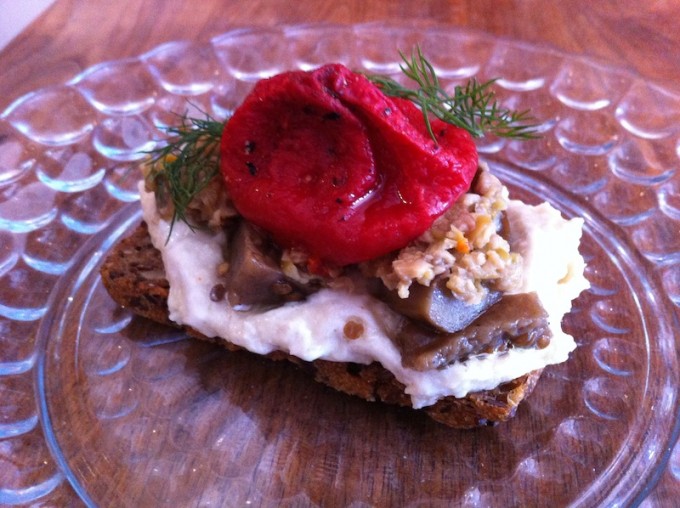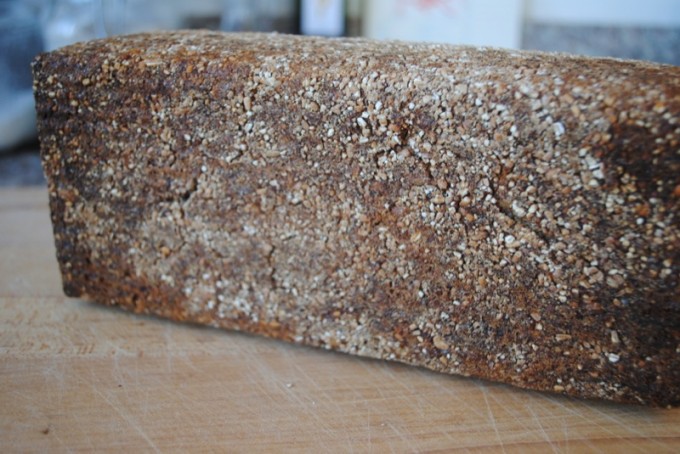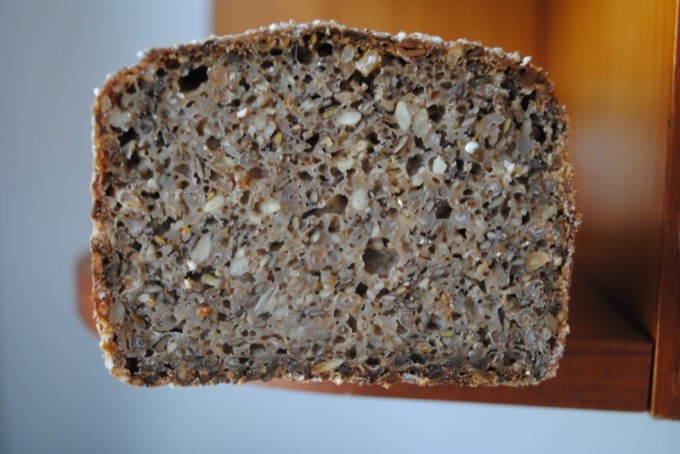Chad Robertson's Rugbrøt
 As you can probably tell from my name(it's Jorgen in case you're wondering) I have Scandinavian roots in my family. My great grandparents were immigrants from Norway and while I don't speak Norwegian nor have I ever been there, I've always felt a connection to Norway and the Scandinavian countries in general(I almost always root for the Norwegians when the Olympics come around, which for some reason is much more successful in the winter.). So when I was pointed, by breadsong at the fresh loaf, to this article and formula, written by Chad Robertson, I got excited and knew I had to give it a try.
As you can probably tell from my name(it's Jorgen in case you're wondering) I have Scandinavian roots in my family. My great grandparents were immigrants from Norway and while I don't speak Norwegian nor have I ever been there, I've always felt a connection to Norway and the Scandinavian countries in general(I almost always root for the Norwegians when the Olympics come around, which for some reason is much more successful in the winter.). So when I was pointed, by breadsong at the fresh loaf, to this article and formula, written by Chad Robertson, I got excited and knew I had to give it a try.

I was further interested in trying this bread when I stopped off at Bar Tartine's new sandwich shop on the way home from work one day. This is where Chad Robertson is doing most of his bread experimentation these days so I was hoping to taste something new and interesting. I went in to try and get one of the Smørrebrød(an open faced danish sandwich) but upon entering I was informed that they had just closed. However, they also informed me that they would be happy to make one for me anyways, on the house, so I could get a taste of what they do there! What great customer service! I knew I would be coming back even before I got to taste the Smørrebrød. The Smørrebrød I ended up getting consisted of eggplant, white bean puree and a whole roasted tomato all served on an extremely delicious and seed-dense slice of rye. It was soooo good. Upon comparing the bread from the Smørrebrød to the formula posted on Food Arts I was fairly certain they were one in the same or at least very similar.

I've already been doing a bit of rye baking recently(See: Sprouted Vollkornbrot with Seeds) and loving the flavor, heartiness and keeping qualities, however, Chad Robertson's formula brings some interesting new ideas to the table that I've never tried before. For one thing, the loaf is partially hydrated with buttermilk and beer. Such a combination sounded too delicious to resist. His loaf is also extremely seed and rye berry dense. The total seeds and rye berries in the formula add up to over 170% of the flour! I'd certainly never pushed seed content that high in any loaf so it was all the more enticing(I love trying new things). Finally I had never retarded a loaf with a high percentage of rye because of concerns about high levels of sourness but Robertson goes for it. And when in doubt, listen to Robertson.
This dough was a little bit scary in the beginning stages of the mix. It started out extremely wet. At first I was seriously concerned that there was a misprint in the formula but as I added seeds and rye berries into the dough, and they started to absorb some of the water, the dough came together some and became more manageable. Let me warn you though that it is still an extremely wet dough so don't panic if you give it a shot. Also, there are no guidelines as to what the dough should feel like at each stage. I would have to rely on the times and temperatures he states in the formula and my own baker's intuition to get through.
I ended up modifying the process some by switching the retarding to the bulk instead of shaped to accommodate my schedule. I also doubled the sunflower seeds because I didn't have pumpkin seeds on hand and used my remaining sprouted rye from my Vollkornbrot bake in place of some of the soaked rye berries. In the article Robertson mentions using sprouted grain in several of his breads so I felt like this would be a proper fit.
This loaf is my new favorite rye bread! I love how many seeds there are. It's almost like you're eating seeds held together with rye and spelt flour which is quite pleasing actually. Also there is only a slight hint of sourness despite retarding the dough. The only disappointment is that the beer and buttermilk flavors don't really come through. I think if I was to make this loaf again I would increase these two ingredients. Perhaps even replace all the water with beer.
I ended up taking a few slices of this loaf with me on a rock climbing session in place of energy bars. It worked great! One or two slices gave me plenty of energy and kept me feeling nourished for hours without the sugar rush feeling. I'm guessing that was the effect of all the seeds, whole grains and good carbs slowly digesting. I may have to try adding some dried fruit to the bread though to make it the ultimate climbing snack.
Formula - Chad Robertson's Rugbrøt(with Modifications)
This is my adapted version of Chad's formula based on the ingredients I had on hand and the equipment I had available. Note: There were some typos and math errors in this formula which have been corrected as of 3/23/2014.
| Baker's % | Ingredient | 1100g. Loaf |
|---|---|---|
| 34.40 | Buttermilk | 80.00 |
| 25.80 | Dark Beer | 60.00 |
| 4.30 | Honey | 10.00 |
| 73.11 | Whole Spelt Flour | 170.00 |
| 26.88 | Dark Rye Flour | 62.50 |
| 38.70 | Flax Seeds | 90.00 |
| 19.35 | Sesame Seeds | 45.00 |
| 17.20 | Sunflower Seeds | 40.00 |
| 5.30 | Salt | 12.50 |
| 98.90 | Rye Berries(Soaked) | 230.00 |
| 93.50 | Water | 217.50 |
| 58.06 | Liquid Levain | 135.00 |
| 495.57 | Total | 1152.50 |
Process(Hand Mix)
- Combine all ingredients except the salt and rye berries in a bowl by stirring with a spoon for 5 minutes. Desired dough temperature: 80F.
- Let the dough rest 10 minutes.
- Stir in the salt and rye berries and mix with a spoon for another 10 minutes. According to Robertson the dough should be like wet concrete at this stage. For me, the dough was quite wet but not as wet as when I first started the mix. It seemed as though the seeds and grains were starting to absorb more of the water, stiffening the dough slightly.
- Let the dough ferment for 2 hours at around 80F and then retard the dough for 8-12 hours in the fridge.(This is where I deviated from Robertson's instructions. He bulks the dough for 3 hours, shapes and then proofs the dough for 2 hours followed by a retard in the fridge overnight. If you follow Robertson's instructions ignore the next three steps.)
- Remove the dough from the fridge and let dough sit out in a warm place for 1 hour.
- Use wet hands to shape the dough into a log, roll in pumpernickle flour and place in an oiled pullman pan.
- Proof the dough for 2 hours in a warm place. Expect to see a good amount of rise. The dough felt quite aerated when it was ready to go
- Bake in a 425 degree oven for 75-90 minutes with steam or a cover on the pullman for the first 15 minutes.
- Remove from the oven and immediately de-pan. Allow the dough to cool and then wrap in a kitchen towel or paper for 24 hours before slicing. Good luck!
Submitted to Yeast Spotting



